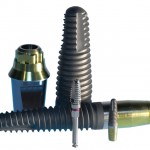
Dental implants are in regular use and generally have good survival rates. However sufficient bone is required in order to place standards length implants without resort to bone regeneration procedures. Consequently, the use of short (≤8 mm) or extra- short (≤6 mm) implants has been reported as a potential option.
The aim of this review was to compare the clinical outcomes of extra-short implants (≤6 mm) versus ≥10 mm long implants, with and without bone augmentation procedures.
Methods
Searches were conducted in the Medline and Embase databases supplemented by manual searches of the periodontal/implantology journals form 2016-2018. Randomised controlled trials (RCTs) in patients comparing extra-short and long implants with a minimum follow-up of 1 year after prosthetic loading were considered.
Two reviewers selected studies with 3 reviewers independently extracting data. Risk of bias was assessed by 2 reviewers independently using the Cochrane tool. The primary outcome was implant survival with marginal bone loss, prosthetic and biological complications as secondary outcomes. Meta-analysis was conducted to compare all the outcome variables with the effect of bone augmentation procedures and other clinical covariates being assessed by meta-regression.
Results
- 18 studies involving 1,612 implants (793 extra-short and 820 long implants) were included.
- 1 study was considered to be at low risk of bias, 8 moderate risk and 4 high risk.
- The overall survival rate was 97.1%, 96.7% for extra-short and 97.5% for long implants.
- A comparison of survival rates for impants at differnt time intervals is shown in the table below.
| Survival rate extra short v long implants | No. of studies | Risk Ratio (95%CI) |
| 1 year | 13 | 1.01 (0.99 – 1.02) |
| 3 years | 9 | 0.99 (0.97 – 1.01) |
| 5 years | 3 | 0.92 (0.86 – 0.99) |
- Extra-short implants displayed less marginal bone loss (MBL) at 1 and 3 years.
- There was no difference in prosthetic complication rate between the extra-short and long implant groups at one-year RR = 0.68 (95%CI; 0.37–1.25) but a significantly higher rate at 3 years RR = 2.29 (95%CI;1.08–4.85).
Conclusions
The authors concluded: –
Placement of extra-short implants (≤6 mm) presented as an equivalent option in the treatment of patients with an atrophic posterior arch up to 3-year follow-up. However, the long-term effectiveness of extra-short dental implants remains to be further studied.
Comments
We have previous looked at reviews comparing long and short dental implants (Dental Elf 12th – 2017). The authors of this review have only searched two major databases so it is possible that relevant studies could have been missed. Only one of the included studies was considered to be at low risk of bias and bias was only rated for 13 of the 18 included studies as the other 5 studies reported data from cohorts included in other included studies.
Only 3 of the studies involved a follow up time of at least 5 years and while the review suggests that there was no difference in survival rates up 3 years lower survival rates were seen rate for the extra short implant at 5 years. With data from reviews of standard implants demonstrating high survival at 10 years or more there is a need to gather additional long term survival data on extra-short dental implants.
Links
Primary Paper
Ravidà A, Wang IC, Barootchi S, Askar H, Tavelli L, Gargallo-Albiol J, Wang HL. Meta-analysis of randomized clinical trials comparing clinical and patient-reported outcomes between extra-short (≤6 mm) and longer (≥10 mm) implants. J Clin Periodontol. 2019 Jan;46(1):118-142. doi: 10.1111/jcpe.13026.Epub 2018 Nov 29. Review. PubMed PMID: 30362137.
Protocol for the review on PROSPERO
Other references
Dental Elf 12th – 2017
